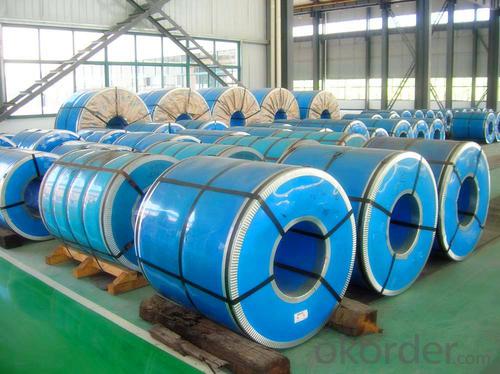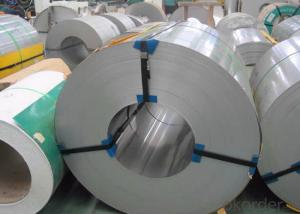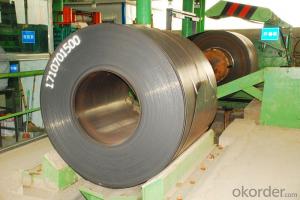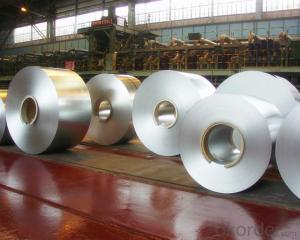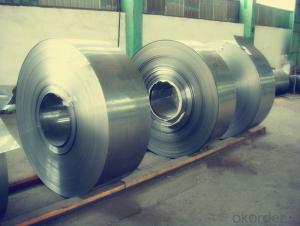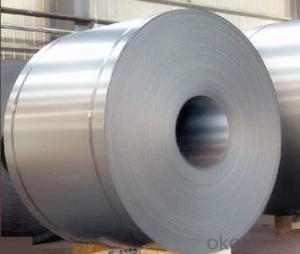Stainless Steel Coil 201 Hot / Cold Rolled Coil Narrow / Wide
- Loading Port:
- Lianyungang
- Payment Terms:
- TT OR LC
- Min Order Qty:
- 400 m.t.
- Supply Capability:
- 5000 m.t./month
OKorder Service Pledge
OKorder Financial Service
You Might Also Like
201 Hot Rolled Stainless Steel Coil Specifications
THK:2.3/2.5/3.0/4.0mm
Width:485/510/550/610/1010/1240mm
Face:No.1
201 Hot rolled stainless steel Coil Application
Stainless steel is a production which not easy rust,acid resistance and corrosion resistance,so it is widely
used in light industry,heavy industry,daily necessities and the decoration industry.
201 hot rolled stainless steel coil, use to produce cold rolled stainless steel coil and stainless steel tube, pipe.
201 Hot Stainless Steel Coil Chemical Composition(WT%)
(C):≤0.15, (Si):≤0.75, (Mn):5.5~7.50, (Cr):16.0~18.0, (N):≤0.25, (Ni):3.50~5.50, (P):≤0.060, (S):≤0.030
201 Hot Rolled Stainless Steel Coil
Strength Of Extension:100,000 To 180,000 Psi;
Yield Strength:50,000 To 150,000 Psi
Elongation :55 To 60%;
Modulus Of Elasticity:29,000,000 Psi;
Density :.280lbs/Cubic Inch(7.93g/Cm3)
- Q: Can stainless steel strips be used in elevator components?
- Yes, stainless steel strips can be used in elevator components due to their durability, corrosion resistance, and strength.
- Q: Can stainless steel strips be used in the medical implants?
- Medical implants can indeed utilize stainless steel strips. This material boasts durability and resistance to corrosion, rendering it appropriate for deployment in medical devices and implants. Commonly, it finds extensive application in orthopedic implants like bone plates, screws, and wires, alongside cardiovascular stents and dental implants. Stainless steel also possesses exceptional biocompatibility, ensuring compatibility with the human body and averting adverse reactions or toxicity. Furthermore, it facilitates straightforward sterilization, a vital aspect for medical implants to prevent infections. Consequently, stainless steel strips constitute a dependable and widely employed substance in the fabrication of medical implants.
- Q: Are stainless steel strips resistant to erosion?
- Yes, stainless steel strips are highly resistant to erosion.
- Q: Are stainless steel strips suitable for chemical reactors?
- Yes, stainless steel strips are suitable for chemical reactors. Stainless steel is a popular material choice for chemical reactors due to its excellent corrosion resistance properties. It is resistant to many corrosive chemicals, including acids, bases, and salts, making it highly suitable for use in various chemical processes. Stainless steel strips offer good structural strength, thermal stability, and durability, making them an ideal choice for constructing the shell and internal components of chemical reactors. Additionally, stainless steel is easy to clean and maintain, which is crucial in ensuring the integrity and efficiency of the chemical reactor. Overall, stainless steel strips are a reliable and suitable material for chemical reactors, providing the necessary resistance and performance required for handling various chemical reactions.
- Q: How do stainless steel strips resist crevice corrosion in seawater?
- The unique chemical composition and passive protective layer of stainless steel strips make them resistant to crevice corrosion in seawater. Stainless steel primarily consists of iron, chromium, and other alloying elements like nickel and molybdenum. The presence of high chromium content, typically above 10.5%, is crucial in preventing crevice corrosion. When stainless steel strips come into contact with seawater, the chromium in the alloy reacts with oxygen to create a thin, transparent oxide layer on the surface, known as the passive layer. This passive layer is highly resistant to corrosion, including crevice corrosion. It acts as a protective barrier between the metal and the corrosive environment, preventing the initiation and spread of corrosion in crevices or tight spaces. The passive layer has the ability to self-heal. If it is damaged or removed, it can quickly reform in the presence of oxygen. This characteristic ensures long-term protection against crevice corrosion in seawater, even in challenging marine environments where the metal is constantly exposed to chloride ions and other aggressive elements. Moreover, the addition of alloying elements such as nickel and molybdenum further enhances the corrosion resistance of stainless steel strips. Nickel improves the stability and durability of the passive layer, while molybdenum enhances the alloy's ability to resist pitting and crevice corrosion in chloride-rich environments like seawater. In conclusion, the resistance of stainless steel strips to crevice corrosion in seawater is due to the formation of a protective passive layer on their surface. The high chromium content, along with other alloying elements, enhances the corrosion resistance and durability of the material, making it an excellent choice for various marine applications.
- Q: Are stainless steel strips suitable for brewery tanks?
- Yes, stainless steel strips are highly suitable for brewery tanks. Stainless steel is a popular choice for brewery equipment due to its excellent corrosion resistance, durability, and hygienic properties. The use of stainless steel strips ensures that the tanks are resistant to rust, staining, and chemical reactions, making them ideal for storing and fermenting beer. Additionally, stainless steel is easy to clean, which is crucial for maintaining the quality and flavor of the beer. Therefore, using stainless steel strips in brewery tanks is a reliable and practical choice for the brewing industry.
- Q: What are the common thicknesses available for stainless steel strips?
- The common thicknesses available for stainless steel strips range from 0.1mm to 6.0mm.
- Q: What is the yield strength of stainless steel strips?
- The yield strength of stainless steel strips is subject to variation based on the particular grade and thickness of the material. Typically, stainless steel strips exhibit superior yield strength in comparison to alternative steel types owing to their composition, which entails a minimum of 10.5% chromium. Nevertheless, the yield strength can span from approximately 200 megapascals (MPa) for subpar stainless steel strips to more than 1000 MPa for top-notch stainless steel strips. It is imperative to refer to the manufacturer's specifications or conduct material testing in order to ascertain the precise yield strength of a given stainless steel strip.
- Q: What is the tensile strength of stainless steel strips?
- The tensile strength of stainless steel strips can vary depending on the grade and thickness of the material. However, on average, stainless steel strips have a tensile strength ranging from 550 to 800 megapascals (MPa).
- Q: Can stainless steel strips be used in power generation plants?
- Power generation plants frequently employ stainless steel strips for a variety of purposes. Stainless steel is an incredibly durable and versatile material that can withstand corrosion, heat, and pressure, making it an excellent choice for numerous applications within these plants. One primary application of stainless steel strips in power plants is the construction of heat exchangers. These devices are vital for transferring heat from one medium to another, such as converting steam into electricity. Stainless steel's resistance to corrosion and ability to withstand high temperatures make it an ideal material for heat exchanger tubes, ensuring their longevity and efficiency. Stainless steel strips are also utilized in the fabrication of various components in power plants, including valves, pumps, and piping systems. The material's strength, resistance to corrosion, and ability to endure high-pressure environments make it suitable for these critical applications. Moreover, stainless steel strips are frequently employed in the production of turbine blades and other parts for steam and gas turbines. These components are exposed to extreme temperatures and mechanical stresses, and stainless steel's capacity to retain its strength and shape under such conditions makes it a reliable choice. Additionally, stainless steel is favored in power generation plants due to its hygienic properties. It is easy to clean and maintain, ensuring that the equipment remains free from contaminants and does not compromise the plant's operations. To summarize, stainless steel strips are commonly used in power generation plants because of their resistance to corrosion, tolerance for high temperatures, strength, and hygienic qualities. From heat exchangers to turbine components, stainless steel is a versatile material that contributes to the efficiency and reliability of power generation processes.
Send your message to us
Stainless Steel Coil 201 Hot / Cold Rolled Coil Narrow / Wide
- Loading Port:
- Lianyungang
- Payment Terms:
- TT OR LC
- Min Order Qty:
- 400 m.t.
- Supply Capability:
- 5000 m.t./month
OKorder Service Pledge
OKorder Financial Service
Similar products
Hot products
Hot Searches
Related keywords




